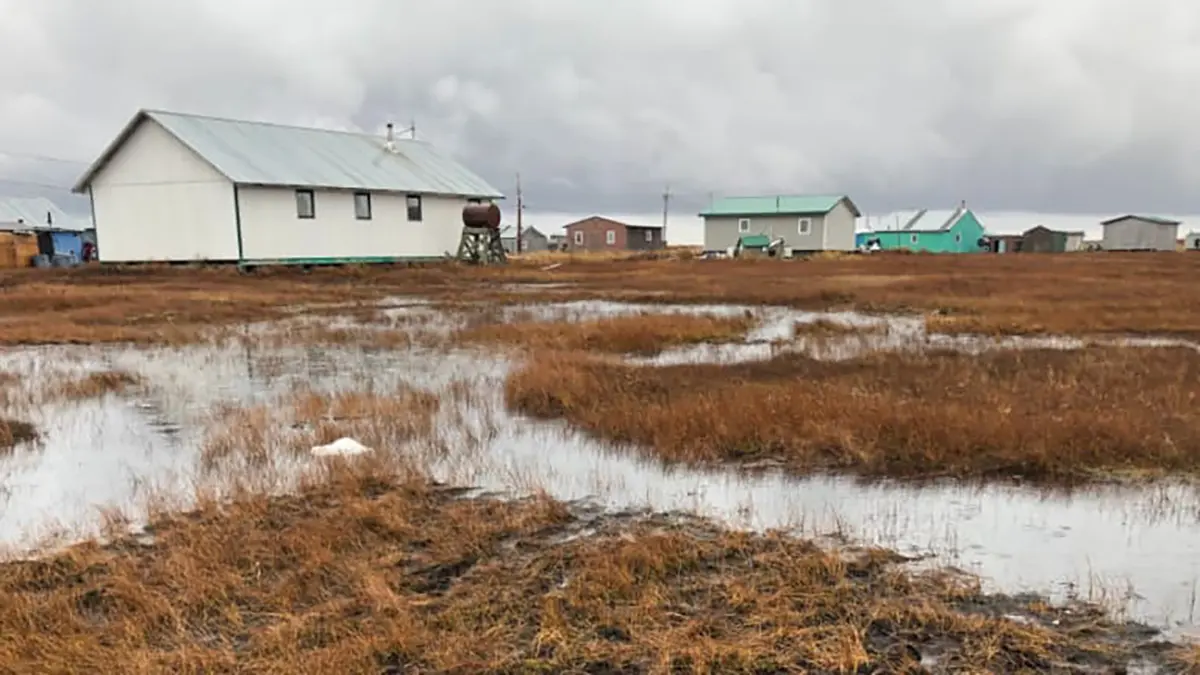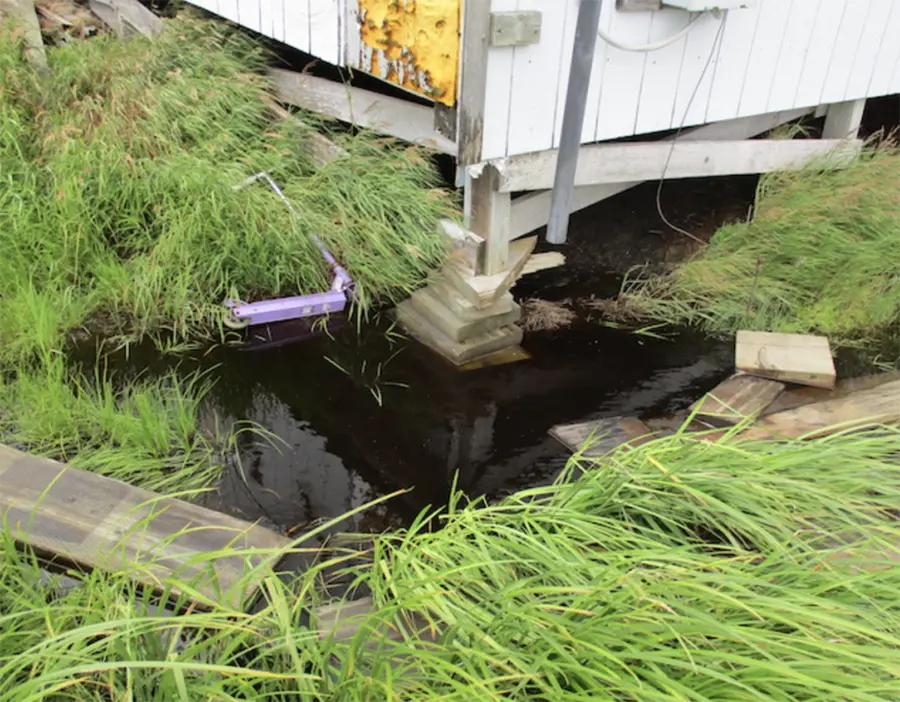
Agency Disaster Programs Overlook Melting Permafrost
ome 80 percent of land in Alaska is made up of permafrost, that is, land that’s been frozen for anywhere from two to a few hundred years. Now, it’s melting. That can lead to collapsed ground, uneven settling, erosion, and flooding. As the ground sinks in some Alaska coastal villages, homes, power plants, and other structures become islands at high tide, not just during extreme weather. Yet, such events don’t qualify as disasters under agency definitions, much less, give reason to grant funds for relocation.
“When we were in (the village of) Nunapitchuk this past summer, part of the school collapsed and then last year the washeteria collapsed,” said Robin Bronen, executive director of the Alaska Institute for Justice, speaking at a recent workshop. “And it’s all because of thawing permafrost.”
“When you have two critical buildings in a community collapsing because of environmental changes and they cannot access disaster funding, that is a giant gap in the ability for communities to get access to funding,” she said.
The problem is federal policies and regulations do not fit Alaska’s unique terrain and climate. That was the message heard at the Rights, Resilience, and Community-Led Climate Adaptation Workshop hosted by the Alaska Institute for Justice, Alaska Native Science Commission, and Permafrost Pathways, on Sept. 19-20 in Anchorage.
One way federal programs do not fit rural Alaska is the requirement for an environmental assessment to qualify for grants. Bronen explained that not only do impoverished villages first have to compete to get the funding for the assessment, but data points sometimes do not add up to a true representation of reality.
Sue Natali is a senior scientist and Arctic Program director for the Woodwell Climate Research Center. She said a map of areas of non-storm flooding was recently brought to the village of Kwigillingok. When locals saw it, “some people laughed. Not that it’s funny, but it was just so off track,” Natali said.
Yet, Bronen said, “when an environmental assessment like the one that Sue just showed for Kwig inaccurately captures what’s actually happening in the community, it affects the prioritization of that community’s ability to get funding. And that is replicated across multiple different government agencies.”
Another issue is that funding is based on cost-benefit analyses. Will the effort and resources that go into a project benefit enough people and preserve enough resources to make it worthwhile?
Bronen said low population numbers raise the per capita cost while aging or damaged infrastructure decreases the value of investing to preserve assets. “And then there are high construction costs and transportation costs and a really big gap that needs to be changed.” She said cost-benefit analyses also ignore the value of culture and community.
Pat Cochran, Inupiaq, is the head of the Native Science Commission. She’s from a village, King Island, which was abandoned when the school was closed. The move, without any support to find a new village site and maintain familial and cultural ties, “was devastating,” Cochran said.
Bronen said if the federal government could just do one thing to change cost benefit analyses, it should create a working group of Alaska Native experts to figure out a way to include subsistence in cost-benefit analyses.
She showed a slide with information from Heather Sauyaq Jean Gordon (Inupiaq), a Child Trends research scientist:
- Subsistence practices support the well-being of over 11 million Indigenous people living in the United States
- Subsistence enculturates Indigenous children and youth
- Subsistence supports Indigenous children’s and families’ health through the physical acts of traditional harvesting and eating nutritious foods
- Subsistence builds people’s relationships with the lands and waters
- Subsistence creates intergenerational social connectedness between family members and the community
- Subsistence engages Indigenous children and families in spirituality and ceremony
Ben Baldwin, Kenaitze Dena’ina Athabascan, is tribal liaison director for the Alaska Institute for Justice. At the end of one discussion, he said, “I just want to take a minute, especially for government agencies, to express that it is very difficult, at least for me, to stay pleasant when we’re talking about the barriers that our people are facing. Sometimes I just want to scream that you’re not helping us, that we’re in danger, that we’re literally being swallowed by deep earth, and we’re being told, ‘It’s going to take 25 years for your community to get to a safe place.’”
He continued, “Is that justice? Is that right? No, it’s not.”
He said Alaskan villages are on the front lines of the climate crisis, and “our people are doing everything that we can to maintain our sense of self, to maintain our sense of community, to maintain our cultures, our languages, and it is exhausting. But we’re doing everything that we can to work together, to stand next to each other and say, ‘This isn’t right and we’re going to help each other.’”
Victoria Salinas, acting deputy administrator for resilience at the Federal Emergency Management Agency, was one of a panel of federal officials who described ways the Biden administration is working to improve agency support. She said a multi-agency, community-driven relocation subcommittee has been created to address the complex emotional and difficult process of relocation.

One change that has been made, she said, was “we made a policy decision that if a community was highly disadvantaged, FEMA would just do the benefit-cost analysis for them because there was nowhere written in law that the burden had to be on a community to do this. That was a policy that had existed and a practice that existed. And so, we changed that and we’re continuing to change it.”
Matthew Dutko is a special assistant who works on implementation of the Bipartisan Infrastructure law at the U.S. Department of the Interior. He said the department “has appropriated more than a hundred million dollars to 11 communities to begin this process (of relocating). And we’re using those funds in conjunction with our colleagues of FEMA and the Tribal Climate Resilience program (at the Bureau of Indian Affairs) to learn just exactly the steps that we need to take in order to get a community from an endangered location to a place where they’re safe.”
Other agencies described programs that go against the usual federal rules. The Department of Agriculture’s Natural Resources Conservation Service, for instance, can fund not just federal disasters but also state-declared disasters. It can also declare a site a local disaster. And the agency includes environmental and social costs and benefits and considerations in its cost-benefit determination.
Darren John, Yup’ik, is Permafrost Pathways liaison for the Native Village of Kwigillingok. He said being a part of the Pathways program has helped him understand procedures for getting relief, and helped his community understand that the problem of thawing permafrost is not going away. “My whole village is on board now for relocation because they see what we are facing,” he said.